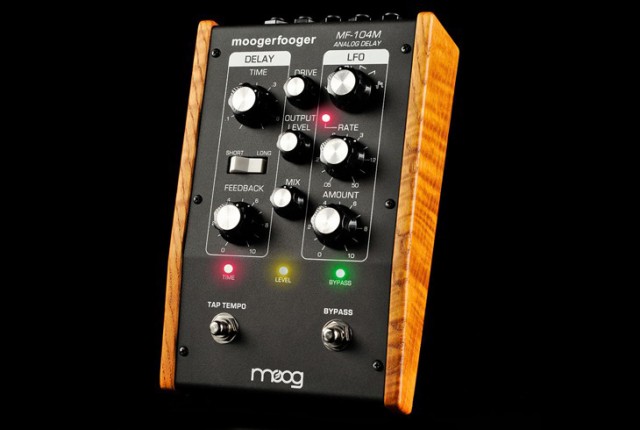
Effective immediately, Moog Music has suspended production of the MF -104M Analog Delay, due to the lack of availability of rare Bucket Brigade Device (BBD) chips.
Moog says that, if they are able to source more of the rare chips, they may resume limited production of the Moogerfooger analog effect pedal.
Originally designed by Bob Moog and released in 2000, the Classic MF-104 Analog Delay was manufactured as a limited edition release of 1000 units. Moog used a “Bucket Brigade” delay chip, allowing the delay to remain completely analog.
The MF-104M recreated the sound and vibe of the Classic MF-104, using the same vintage BBD chips found in the original.
Moog’s MF-Delay Minifooger pedal and 500 Series Analog Delay are still available, via authorized Moog dealers.

Well that’s three they’ve killed off in two weeks. The chorus/flanger also uses a BBD — is that a different chip?
Yes. This chip shortage only affects the MF-104M and the 500 Series Analog Delay, which they’re keeping in production for the time being.
damn, great pedal. Expensive as hell.
Out of curiosity, anyone know which bbd chip it is?
I’m wondering as well.
Could it be the same one EHX and Behringer are using in their delay pedals? That would explain the shortage.
BBD is short for Bridge Bucket Delay. Old technology that’s pretty much useless except for really great sounding delay.
Moogerfoogers are nice products. I have five of them, but I’m afraid Moog is killing those creatures because of faulty pricing strategy.
Some Google activity turned up this info:
In fact the earlier unit used the MN3005 BBD device, while the later one the MN3008.
They can make smart watches and murder people over cobalt, why can’t they produce more BBD chips? I guess all my gear just doubled in value? And I guess I will never be able to afford a MF-104m if I wait like 60 seconds longer to buy one?
watch the news lately?
most of what I see is driven by morons.
even the reporters
I toss a suggestion to Maxim-IC one great IC chip maker,””,why not make some chips for the analog music scene?””
considering they sell a bunch of 2-8 buck complex chips, could not see why they could not make something like a bbd, sid, sn76477, or any other noise making chip
The reason nobody is scrambling to remake the chips is that the music industry as a whole is a tiny market. There’s no money in it. Major manufactures are discontinuing through-hole parts all together, much less fairly obscure BBD chips that have no other application besides niche audio. There are a few companies trying to make audio-specific ICs (most notably CoolAudio and THAT Corp), but they’re fairly boutique and people still complain that “the originals sounded better.”
It’s easy to think that there’s a market for these things, but compared to consumer electronics, automotive, military, and broadcast comms, we’re small beans. Imagine going to the trouble of re-making a vintage IC (incredibly expensive and labor intensive) only to sell 850 of them. We may have finally reached the point of extinction (at least, until we can print our own ICs on our household 3D printers).
If it is so impractical to make ICs for such a small market, how was it ever feasible to make them in the first place? And how is it that in the 1980s it was so easy to get Curtis and SSM chips?
well the thing is the chips can used in something besides hobbyist
The SID chip was a general sound maker in a computer made i the millions
the 76477 was used in alarms and warning devices
and some audio processing circuits used various chips on a commercial scale
If anything that has been leading to demise it has been sampling tech, other words software doing the work
Companies like Roland and Yamaha and Korg can pretty much make their own effects that can come close to what BBD’s do. With millions (per co.) in R&D and millions more in Product development and manufacturing in China, it’s hard to compete as a small boutique company.